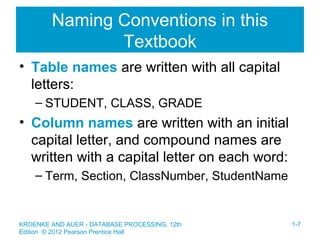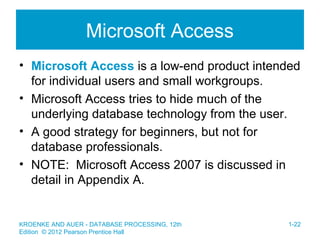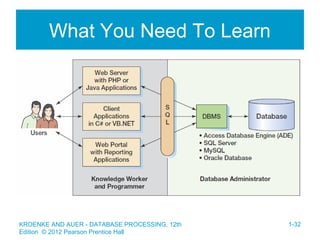Database management chapter 1 power point
- 1. David M. Kroenke and David J. Auer Database Processing—12th Edition Fundamentals, Design, and Implementation Chapter One: Introduction KROENKE AND AUER - DATABASE PROCESSING, 12th Edition © 2012 Pearson Prentice Hall 1-1
- 2. Chapter Objectives • To understand the nature and characteristics of databases • To survey some important and interesting database applications • To gain a general understanding of tables and relationships • To describe the components of a Microsoft Access database system and explain the functions they perform • To describe the components of an enterprise-class database system and explain the functions they perform • To define the term database management system (DBMS) and describe the functions of a DBMS KROENKE AND AUER - DATABASE PROCESSING, 12th Edition © 2012 Pearson Prentice Hall 1-2
- 3. Chapter Objectives • To define the term database and describe what is contained within the database • To define the term metadata and provide examples of metadata • To define and understand database design from existing data • To define and understand database design as new systems development • To define and understand database design in database redesign • To understand the history and development of database processing KROENKE AND AUER - DATABASE PROCESSING, 12th Edition © 2012 Pearson Prentice Hall 1-3
- 4. The Characteristics of Databases • The purpose of a database is to help people track things of interest to them. • Data is stored in tables, which have rows and columns like a spreadsheet. A database may have multiple tables, where each table stores data about a different thing. • Each row in a table stores data about an occurrence or instance of the thing of interest. • A database stores data and relationships. KROENKE AND AUER - DATABASE PROCESSING, 12th Edition © 2012 Pearson Prentice Hall 1-4
- 5. Data in Tables KROENKE AND AUER - DATABASE PROCESSING, 12th Edition © 2012 Pearson Prentice Hall 1-5
- 6. The Key Characteristic of Databases: Related Tables KROENKE AND AUER - DATABASE PROCESSING, 12th Edition © 2012 Pearson Prentice Hall 1-6
- 7. Naming Conventions in this Textbook • Table names are written with all capital letters: – STUDENT, CLASS, GRADE • Column names are written with an initial capital letter, and compound names are written with a capital letter on each word: – Term, Section, ClassNumber, StudentName KROENKE AND AUER - DATABASE PROCESSING, 12th Edition © 2012 Pearson Prentice Hall 1-7
- 8. Databases Create Information • Data = recorded facts and figures • Information = knowledge derived from data • Databases record data, but they do so in such a way that we can produce information from the data. – The data on STUDENTs, CLASSes, and GRADEs could produce information about each student’s GPA. KROENKE AND AUER - DATABASE PROCESSING, 12th Edition © 2012 Pearson Prentice Hall 1-8
- 9. Database Examples KROENKE AND AUER - DATABASE PROCESSING, 12th Edition © 2012 Pearson Prentice Hall 1-9
- 10. Components of a Database System KROENKE AND AUER - DATABASE PROCESSING, 12th Edition © 2012 Pearson Prentice Hall 1-10
- 11. Components of a Database System with SQL KROENKE AND AUER - DATABASE PROCESSING, 12th Edition © 2012 Pearson Prentice Hall 1-11
- 12. Applications, the DBMS, and SQL • Applications are the computer programs that users work with. • The Database Management System (DBMS) creates, processes, and administers databases. • Structured Query Language (SQL) is an internationally recognized standard database language that is used by all commercial DBMSs. KROENKE AND AUER - DATABASE PROCESSING, 12th Edition © 2012 Pearson Prentice Hall 1-12
- 13. Database Applications KROENKE AND AUER - DATABASE PROCESSING, 12th Edition © 2012 Pearson Prentice Hall 1-13
- 14. Database Applications—Forms KROENKE AND AUER - DATABASE PROCESSING, 12th Edition © 2012 Pearson Prentice Hall 1-14
- 15. Database Applications—Queries SELECT LastName, FirstName, EmailAddress FROM STUDENT WHERE StudentNumber > 2; KROENKE AND AUER - DATABASE PROCESSING, 12th Edition © 2012 Pearson Prentice Hall 1-15
- 16. Database—Reports KROENKE AND AUER - DATABASE PROCESSING, 12th Edition © 2012 Pearson Prentice Hall 1-16
- 17. The DBMS KROENKE AND AUER - DATABASE PROCESSING, 12th Edition © 2012 Pearson Prentice Hall 1-17
- 18. The Database • A database is a self-describing collection of integrated tables. • The tables are called integrated because they store data about the relationships between the rows of data. • A database is called self-describing because it stores a description of itself. • The self-describing data is called metadata, which is data about data. KROENKE AND AUER - DATABASE PROCESSING, 12th Edition © 2012 Pearson Prentice Hall 1-18
- 19. Typical Metadata Tables KROENKE AND AUER - DATABASE PROCESSING, 12th Edition © 2012 Pearson Prentice Hall 1-19
- 20. Database Contents KROENKE AND AUER - DATABASE PROCESSING, 12th Edition © 2012 Pearson Prentice Hall 1-20
- 21. Personal Database Systems: Microsoft Access KROENKE AND AUER - DATABASE PROCESSING, 12th Edition © 2012 Pearson Prentice Hall 1-21
- 22. Microsoft Access • Microsoft Access is a low-end product intended for individual users and small workgroups. • Microsoft Access tries to hide much of the underlying database technology from the user. • A good strategy for beginners, but not for database professionals. • NOTE: Microsoft Access 2007 is discussed in detail in Appendix A. KROENKE AND AUER - DATABASE PROCESSING, 12th Edition © 2012 Pearson Prentice Hall 1-22
- 23. What Is Microsoft Access? • Microsoft Access is a DBMS plus an application generator: – The DBMS creates, processes, and administers Microsoft Access databases. – The application generator includes query, form, and report components. • The Microsoft Access DBMS engine is called the Access Data Engine (ADE). • Microsoft Access 2000 and later can be used as an application generator for the Microsoft SQL Server DBMS. KROENKE AND AUER - DATABASE PROCESSING, 12th Edition © 2012 Pearson Prentice Hall 1-23
- 24. Enterprise-Class Database Systems KROENKE AND AUER - DATABASE PROCESSING, 12th Edition © 2012 Pearson Prentice Hall 1-24
- 25. Prominent DBMS Products • Microsoft Access 2010 • Microsoft SQL Server 2008 R2 –Microsoft SQL Server 2008 R2 Express • Oracle Corporation Oracle Database 11g • MySQL 5.5 • IBM DB2 KROENKE AND AUER - DATABASE PROCESSING, 12th Edition © 2012 Pearson Prentice Hall 1-25
- 26. DBMS Power vs. Ease of Use KROENKE AND AUER - DATABASE PROCESSING, 12th Edition © 2012 Pearson Prentice Hall 1-26
- 27. Three Types of Database Design KROENKE AND AUER - DATABASE PROCESSING, 12th Edition © 2012 Pearson Prentice Hall 1-27
- 28. Database Design from Existing Data KROENKE AND AUER - DATABASE PROCESSING, 12th Edition © 2012 Pearson Prentice Hall 1-28
- 29. Data Import: One or Two Tables? This is an important decision, and based on a set of rules known as normalization (which is covered in Chapter 3). KROENKE AND AUER - DATABASE PROCESSING, 12th Edition © 2012 Pearson Prentice Hall 1-29
- 30. Database Design from New Systems Development Entity-Relationship data modeling is covered in Chapter 5, and data model transformations to database designs are covered in Chapter 6. KROENKE AND AUER - DATABASE PROCESSING, 12th Edition © 2012 Pearson Prentice Hall 1-30
- 31. Database Design from Database Redesign Database redesign is covered in Chapter 8, after coverage of SQL in Chapter Seven. KROENKE AND AUER - DATABASE PROCESSING, 12th Edition © 2012 Pearson Prentice Hall 1-31
- 32. What You Need To Learn KROENKE AND AUER - DATABASE PROCESSING, 12th Edition © 2012 Pearson Prentice Hall 1-32
- 33. Knowledge Priorities KROENKE AND AUER - DATABASE PROCESSING, 12th Edition © 2012 Pearson Prentice Hall 1-33
- 34. A Brief History of Database Processing I KROENKE AND AUER - DATABASE PROCESSING, 12th Edition © 2012 Pearson Prentice Hall 1-34
- 35. A Brief History of Database Processing II KROENKE AND AUER - DATABASE PROCESSING, 12th Edition © 2012 Pearson Prentice Hall 1-35
- 36. The Relational Database Model • The dominant database model is the relational database model—all current major DBMS products are based on it. • It was created by IBM engineer E. F. Codd in 1970. • It was based on mathematics called relational algebra. • This text examines and explains the relational database model. KROENKE AND AUER - DATABASE PROCESSING, 12th Edition © 2012 Pearson Prentice Hall 1-36
- 37. David Kroenke and David Auer Database Processing—12th Edition Fundamentals, Design, and Implementation End of Presentation: Chapter One KROENKE AND AUER - DATABASE PROCESSING, 12th Edition © 2012 Pearson Prentice Hall 1-37
- 38. All rights reserved. No part of this publication may be reproduced, stored in a retrieval system, or transmitted, in any form or by any means, electronic, mechanical, photocopying, recording, or otherwise, without the prior written permission of the publisher. Printed in the United States of America. Copyright © 2012 Pearson Education, Inc. Copyright © 2012 Pearson Education, Inc. Publishing as Prentice HallPublishing as Prentice Hall KROENKE AND AUER - DATABASE PROCESSING, 12th Edition © 2012 Pearson Prentice Hall 1-38





































